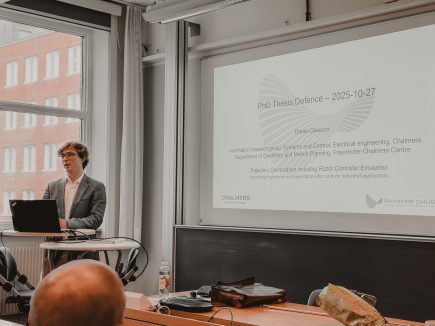On Monday, 27 October 2025, our colleague Daniel Gleeson presented and defended his thesis for the degree of Doctor of Philosophy ”Trajectory Optimization including Robot Controller Emulation”
Abstract
The manufacturing industry has seen an ever-increasing level of automation with fully automated robotic assembly lines being commonplace in a wide variety of manufacturing industries. The automotive industry has had a prominent position in driving this development, and increasing the extent of automation has been a natural way to handle complex manufacturing processes and high throughput production. With industrial robots becoming cheaper and more available and product complexity and customization increasing, the use of robotics in industrial settings shows no signs of slowing down. With automated production lines, the use of simulation models and virtual commissioning has a place in every modern factory. A driving overall goal is to produce a virtual representation of the physical world, with a digital representation of every step in the manufacturing process, including CAD-file descriptions of both the production cell and the final product, specific process information, and full factory layouts. The work presented in this thesis is all related to bridging the gap between the digital and physical world, optimizing both the quality of the product and the efficiency of the robotic manufacturing process, while simplifying the work needed to be done to realize these solutions. One main contribution is modelling and optimizing collision free industrial robot trajectories in a cluttered environment, with trajectories defined by instantaneous torque values or as robot code equivalent parametrizations. To implement these solutions for a wide variety of robots, a robot controller emulator that executes robot code and accurately calculates the resulting robot trajectories has been developed. Improved and automated robot trajectories have been used in several applications, including in manufacturing processes that require advanced modelling techniques, such as the accurate modelling and optimization of robotic spray-painting trajectories.
We congratulate Daniel and look forward to keep working with him here at FCC!

